MERCEDES-BENZ SPRINTER 2019 MY19 with 7” screen
Manufacturer: MERCEDES-BENZ, Model Year: 2019, Model line: SPRINTER, Model: MERCEDES-BENZ SPRINTER 2019Pages: 354, PDF Size: 6.15 MB
Page 291 of 354
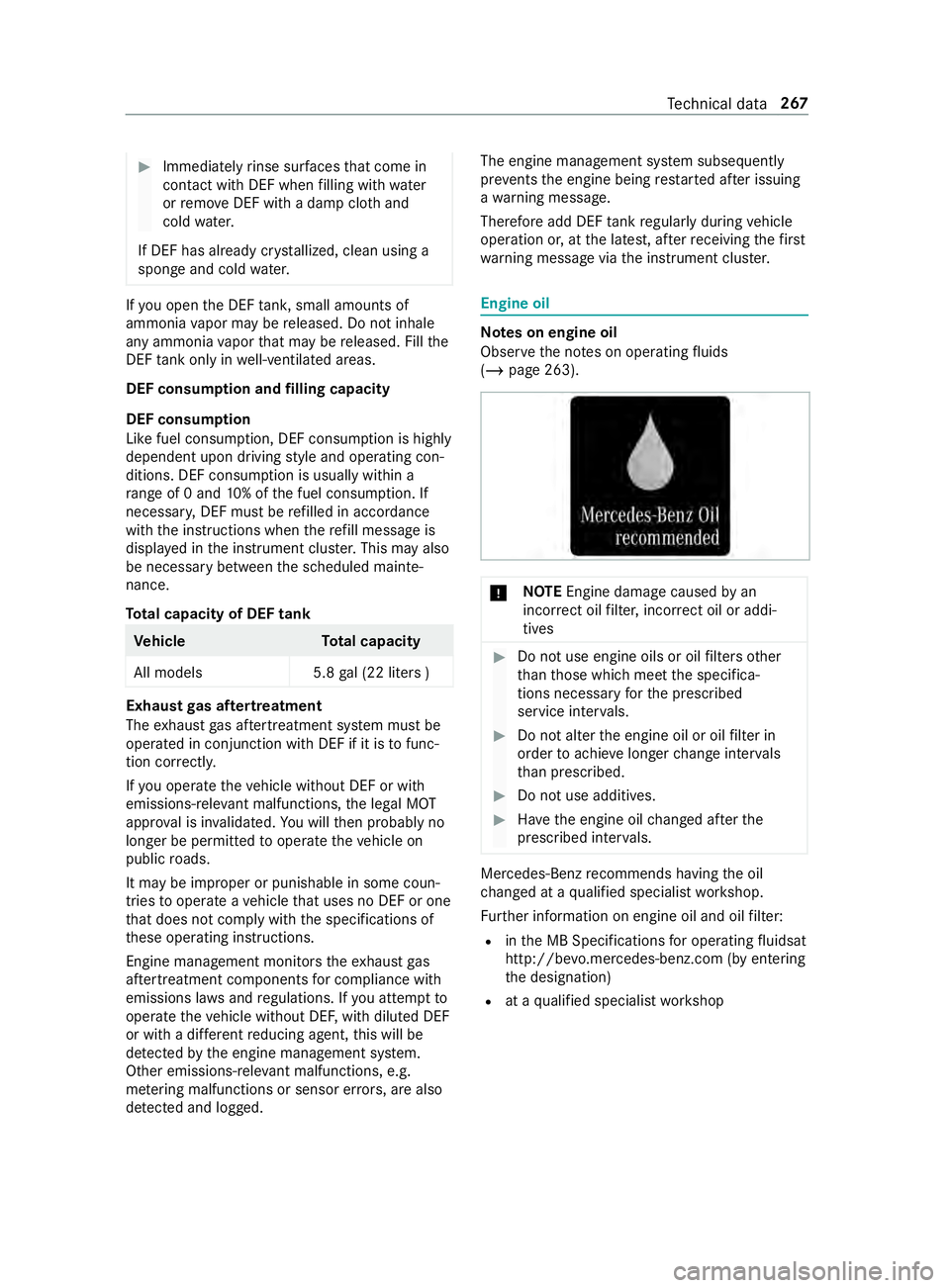
#
Immedia tely rinse su rfaces that come in
con tact wi thDEF when filling with water
or remo veDEF wi tha damp clo thand
cold water.
If DEF has already cr ystallized, clean using a
spon geand cold water. If
yo u open the DEF tank, small amounts of
ammonia vapor may be released. Do not inhale
any ammonia vapor that may be released. Fill the
DEF tank only in well-ventilated areas.
DEF consum ption and filling capacity
DEF consum ption
Like fuel consum ption, DEF consum ption is highly
dependent upon driving style and operating con‐
ditions. DEF consum ption is usually within a
ra nge of 0 and 10% of the fuel consum ption. If
necessar y,DEF mu stbe refilled in acco rdance
with the instructions when there fill message is
displa yed in the instrument clus ter.This may also
be necessary between the scheduled mainte‐
nance.
To tal capacity of DEF tank Ve
hicl eT otal capacity
All model s5 .8gal (22 liters ) Exhau
stgas af tertre atment
The exhaust gas af tertre atment sy stem must be
operated in conjunction with DEF if it is tofunc‐
tion cor rectl y.
If yo u operate theve hicle without DEF or with
emissions-rele vant malfunctions, the legal MOT
appr oval is in validated. You will then probably no
longer be permitted tooperate theve hicle on
public roads.
It may be improper or punishable in some coun‐
tries tooperate a vehicle that uses no DEF or one
th at does not comply with the specifications of
th ese operating instructions.
Engine management monitors theex haust gas
af te rtre atment components for compliance with
emissions la wsand regulations. If you attem ptto
operate theve hicle without DEF, with diluted DEF
or with a dif fere nt reducing agent, this will be
de tected bythe engine management sy stem.
Other emissions- releva nt malfunctions, e.g.
me tering malfunctions or sensor er rors, are also
de tected and log ged. The engine management sy
stem subsequently
pr eve nts the engine being restar ted af ter issuing
a wa rning message.
Therefore add DEF tank regular lyduring vehicle
operation or, at the latest, af terre ceiving thefirst
wa rning message via the instrument clus ter. Engine oil
Note
s on engine oil
Obser vethe no tes on operating fluids
(/ page 263). *
NO
TEEngine damage caused byan
incor rect oil filter, incor rect oil or addi‐
tives #
Do not use engine oils or oil filters other
th an those which meet the specifica‐
tions necessary forth e prescribed
service inter vals. #
Do not alter the engine oil or oil filter in
order toachie velonger change inter vals
th an presc ribed. #
Do not use additives. #
Have the engine oil changed af terthe
prescribed inter vals. Mercedes-Benz
recommends having the oil
ch anged at a qualified specialist workshop.
Fu rther information on engine oil and oil filter:
R inthe MB Specifications for operating fluidsat
http://be vo.mercedes-benz.com (by entering
th e designation)
R at a qualified specialist workshop Te
ch nical da ta267
Page 292 of 354
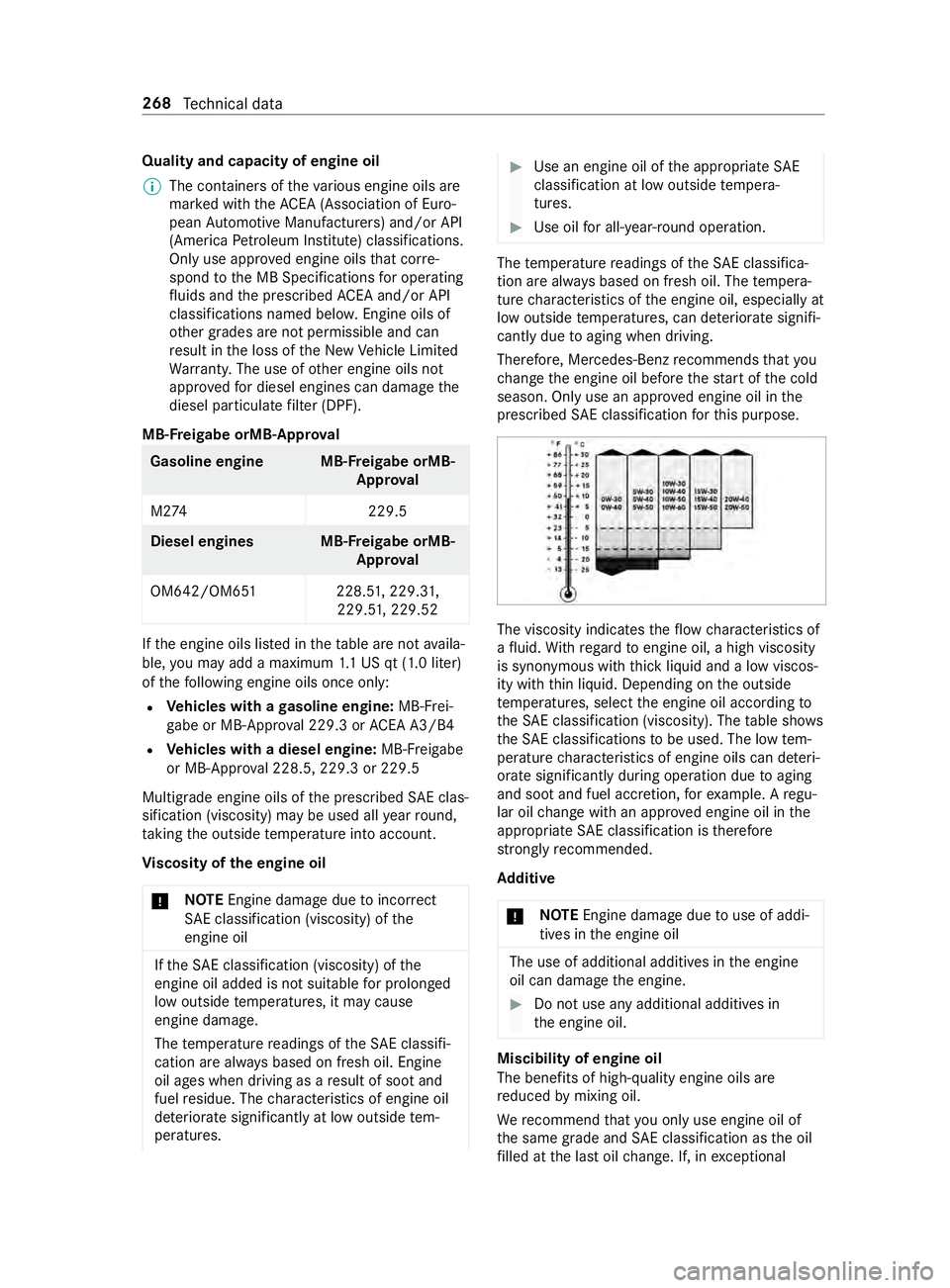
Quality and capacity of engine oil
%
The containers of
theva rious engine oils are
mar ked with theAC EA (Association of Euro‐
pean Automotive Manufacturers) and/or API
(America Petroleum Institu te) classifications.
Only use appr oved engine oils that cor re‐
spond tothe MB Specifications for operating
fl uids and the prescribed ACEA and/or API
classi fications named bel ow. Engine oils of
ot her grades are not permissible and can
re sult in the loss of the New Vehicle Limited
Wa rrant y.The use of other engine oils not
appr ovedfo r diesel engines can dama gethe
diesel particulate filter (DPF).
MB- Freigabe orMB-App roval Gasoline engine MB-F
reigabe orMB-
Appr oval
M2 74 229.5Diesel engine
sMB-Freigabe orMB-
Appr oval
OM642/OM65 1228.51,229.3 1,
229.5 1,229.52 If
th e engine oils lis ted in theta ble are not availa‐
ble, you may add a maximum 1.1 US qt (1.0 liter)
of thefo llowing engine oils once only:
R Vehicles with a gasoline engine: MB-Frei‐
ga be or MB-Appr oval 229.3 or ACEA A3/B4
R Vehicles with a diesel engine: MB-Freigabe
or MB-Appr oval 228.5, 229.3 or 229.5
Multig rade engine oils of the prescribed SAE clas‐
si fication (viscosity) may be used all year round,
ta king the outside temp erature into account.
Vi scosity of the engine oil
* NO
TEEngine damage due toincor rect
SA E classi fication (viscosity) of the
engine oil If
th eSA E classi fication (viscosity) of the
engine oil added is not suitable for prolonged
low outside temp eratures, it may cause
engine damage.
The temp erature readings of theSA E classi fi‐
cation are al ways based on fresh oil. Engine
oil ages when driving as a result of soot and
fuel residue. The characteristics of engine oil
de teriorate significantly at low outside tem‐
peratures. #
Use an engine oil of the appropriate SAE
classi fication at low outside temp era‐
tures. #
Use oil for all-year-round operation. The
temp erature readings of theSA E classi fica‐
tion are al ways based on fresh oil. The temp era‐
ture characteristics of the engine oil, especially at
low outside temp eratures, can de teriorate signifi‐
cantly due toaging when driving.
Therefore, Mercedes-Benz recommends that you
ch ange the engine oil before thest art of the cold
season. Only use an appr oved engine oil in the
prescribed SAE classi fication forth is purpose. The viscosity indicates
theflow characteristics of
a fluid. With rega rd toengine oil, a high viscosity
is synonymous with thick liquid and a low viscos‐
ity with thin liquid. Depending on the outside
te mp eratures, select the engine oil according to
th eSA E classi fication (viscosity). The table sho ws
th eSA E classi fications tobe used. The low tem‐
perature characteristics of engine oils can de teri‐
orate significantly during operation due toaging
and soot and fuel acc retion, forex ample. A regu‐
lar oil change with an appr oved engine oil in the
appropriate SAE classi fication is therefore
stro ngly recommended.
Ad ditive
* NO
TEEngine damage due touse of addi‐
tives in the engine oil The use of additional additives in
the engine
oil can damage the engine. #
Do not use any additional additives in
the engine oil. Miscibility of engine oil
The benefits of high-quality engine oils are
re
duced bymixing oil.
We recommend that you on lyuse engine oil of
th e same grade and SAE classi fication as the oil
fi lled at the last oil change. If, in exceptional 268
Tech nical da ta
Page 293 of 354
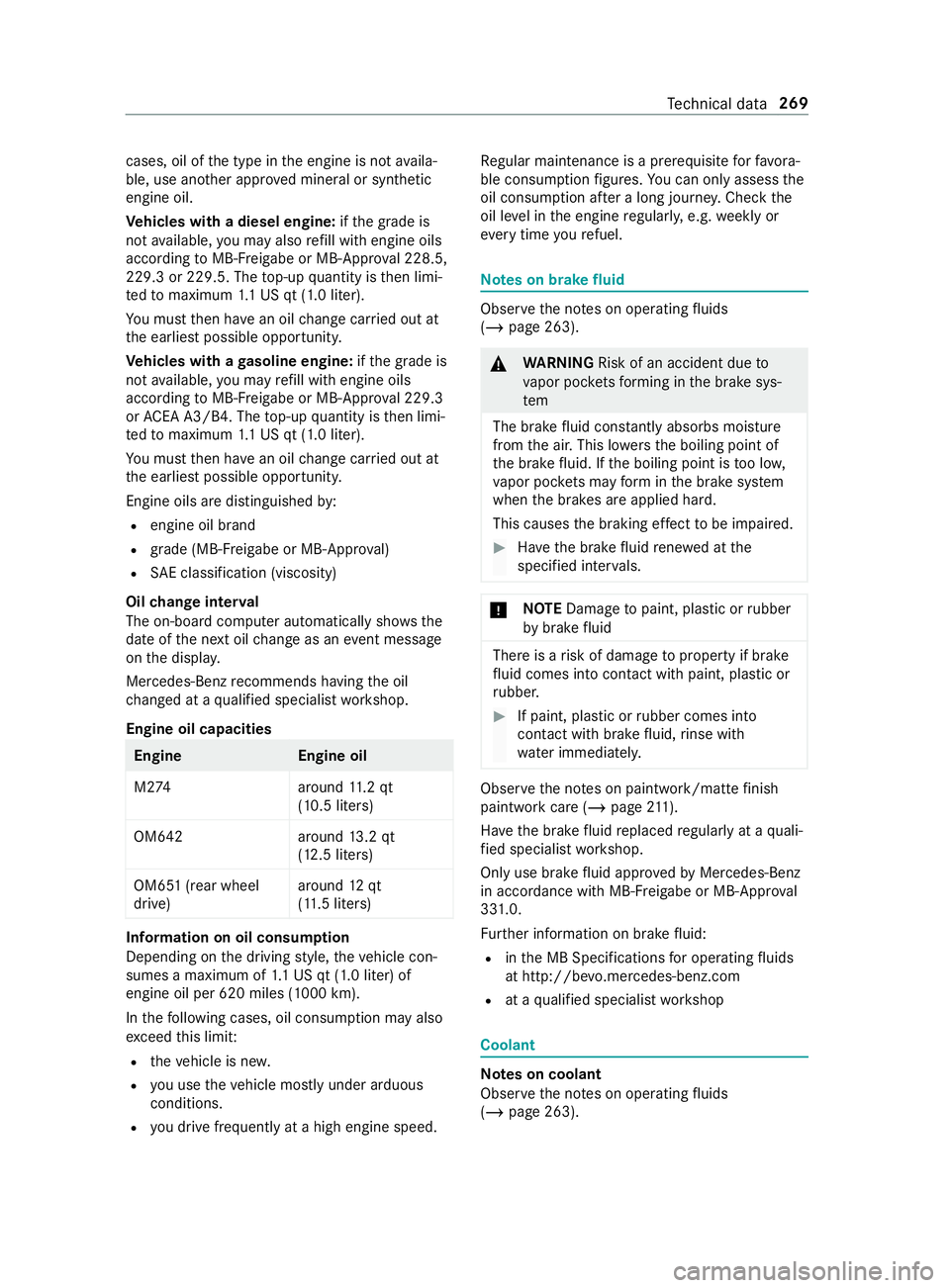
cases, oil of
the type in the engine is not availa‐
ble, use ano ther appr oved mineral or synthetic
engine oil.
Ve hicles with a diesel engine: ifth e grade is
not available, you may also refill with engine oils
acco rding toMB-F reigabe or MB-Appr oval 228.5,
229.3 or 229.5. The top-up quantity is then limi‐
te dto maximum 1.1 US qt (1.0 liter).
Yo u must then ha vean oil change car ried out at
th e earliest possible opportunit y.
Ve hicles with a gasoline engine: ifth e grade is
not available, you may refill with engine oils
acco rding toMB-F reigabe or MB-Appr oval 229.3
or AC EA A3/B4. The top-up quantity is then limi‐
te dto maximum 1.1 US qt (1.0 liter).
Yo u must then ha vean oil change car ried out at
th e earliest possible opportunit y.
Engine oils are di stinguished by:
R engine oil brand
R grade (MB-F reigabe or MB-Appr oval)
R SAE classi fication (viscosity)
Oil change inter val
The on-board computer automatically sho wsthe
date of the next oil change as an event messa ge
on the displa y.
Mercedes-Benz recommends having the oil
ch anged at a qualified specialist workshop.
Engine oil capacities Engine
Engine oil
M2 74 around11.2 qt
(10.5 li ters)
OM642 around13.2 qt
(12.5 li ters)
OM651 (rear wheel
drive) around
12qt
(1 1. 5 liters) Information on oil consum
ption
Depending on the driving style, theve hicle con‐
sumes a maximum of 1.1 US qt (1.0 liter) of
engine oil per 620 miles (1000 km).
In thefo llowing cases, oil consum ption may also
exc eed this limit:
R theve hicle is ne w.
R you use theve hicle mostly under arduous
conditions.
R you drive frequently at a high engine speed. Re
gular maintenance is a prerequisite forfa vo ra‐
ble consum ption figures. You can on lyassess the
oil consum ption af ter a long journe y.Check the
oil le vel in the engine regularly, e.g. weekly or
ev ery time youre fuel. Note
s on brake fluid Obser
vethe no tes on operating fluids
(/ page 263). &
WARNING Risk of an accident due to
va por poc kets form ing in the brake sys‐
tem
The brake fluid con stantly absorbs moisture
from the air. This lo wersthe boiling point of
th e brake fluid. If the boiling point is too lo w,
va por poc kets may form inthe brake sy stem
when the brakes are applied hard.
This causes the braking ef fect to be impaired. #
Have the brake fluid rene we d at the
specified inter vals. *
NO
TEDama getopaint, plastic or rubber
by brake fluid There is a
risk of damage toproperty if brake
fl uid comes into con tact wi thpaint, plastic or
ru bber. #
If paint, plastic or rubber comes into
con tact wi thbrake fluid, rinse wi th
wate r immediatel y. Obser
vethe no tes on paintwork/matte finish
paintwork care (/ page 211).
Ha ve the brake fluid replaced regular lyat a quali‐
fi ed specialist workshop.
Only use brake fluid appr ovedby Mercedes-Benz
in accordance with MB-F reigabe or MB-Appr oval
33 1.0.
Fu rther information on brake fluid:
R inthe MB Specifications for operating fluids
at http://be vo.mercedes-benz.com
R at a qualified specialist workshop Coolant
Note
s on coolant
Obser vethe no tes on operating fluids
(/ page 263). Te
ch nical da ta269
Page 294 of 354
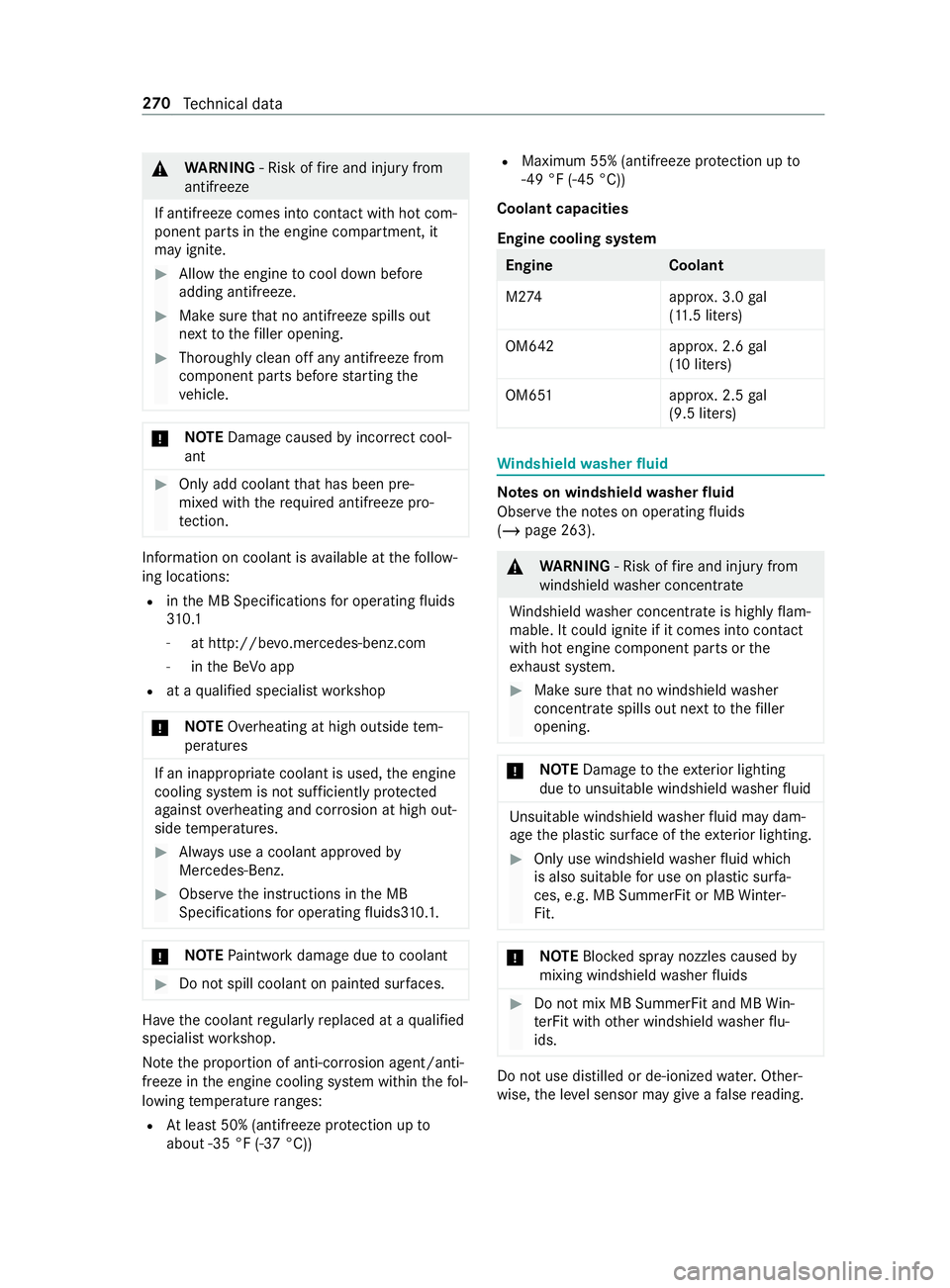
&
WARNING ‑ Risk of fire and injury from
antifreeze
If antifreeze comes into con tact wi thhot com‐
ponent parts in the engine compartment, it
may ignite. #
Allow the engine tocool down before
adding antif reeze. #
Make sure that no antifreeze spills out
next tothefiller opening. #
Thoroughly clean off any antifreeze from
component parts before starting the
ve hicle. *
NO
TEDama gecaused byincor rect cool‐
ant #
Only add coolant that has been pre‐
mixed with therequ ired antifreeze pro‐
te ction. Information on coolant is
available at thefo llow‐
ing locations:
R inthe MB Specifications for operating fluids
31 0.1
- at http://be vo.mercedes-benz.com
- inthe BeVo app
R at a qualified specialist workshop
* NO
TEOverheating at high outside tem‐
peratures If an inapp
ropriate coolant is used, the engine
cooling sy stem is not suf ficiently pr otected
against overheating and cor rosion at high out‐
side temp eratures. #
Always use a coolant appr ovedby
Mercedes-Benz. #
Obser vethe instructions in the MB
Specifications for operating fluids3 10.1 . *
NO
TEPaint wo rkdamage due tocoolant #
Do not spill coolant on painted sur faces. Ha
ve the coolant regularly replaced at a qualified
specialist workshop.
No tethe proportion of anti-cor rosion agent/anti‐
freeze in the engine cooling sy stem within thefo l‐
lowing temp erature ranges:
R Atleast 50% (antifreeze pr otection up to
about -35 °F (-37 °C)) R
Maximum 55% (antifreeze pr otection up to
-49 °F (-45 °C))
Coolant capacities
Engine cooling sy stem Engine
Coolant
M2 74 approx. 3.0 gal
(1 1. 5 liters)
OM642 approx. 2.6 gal
(10 liters)
OM65 1a pprox. 2.5 gal
(9.5 liters) Wi
ndshield washer fluid Note
s on windshield washer fluid
Obser vethe no tes on operating fluids
(/ page 263). &
WARNING ‑ Risk of fire and injury from
windshield washer concentrate
Wi ndshield washer concentrate is highly flam‐
mable. It could ignite if it comes into con tact
wi th hot engine component parts or the
ex haust sy stem. #
Make sure that no windshield washer
concentrate spills out next tothefiller
opening. *
NO
TEDama getotheex terior lighting
due tounsuitable windshield washer fluid Uns
uitable windshield washer fluid may dam‐
age the plastic sur face of theex terior lighting. #
Only use windshield washer fluid which
is also suitable for use on plast ic surfa‐
ces, e.g. MB SummerFit or MB Winter‐
Fit. *
NO
TEBlocked spr aynozzles caused by
mixing windshield washer fluids #
Do not mix MB SummerFit and MB Win‐
te rFit with other windshield washer flu‐
ids. Do not use distilled or de-ionized
water.Other‐
wise, the le vel sensor may give a false reading. 270
Tech nical da ta
Page 295 of 354
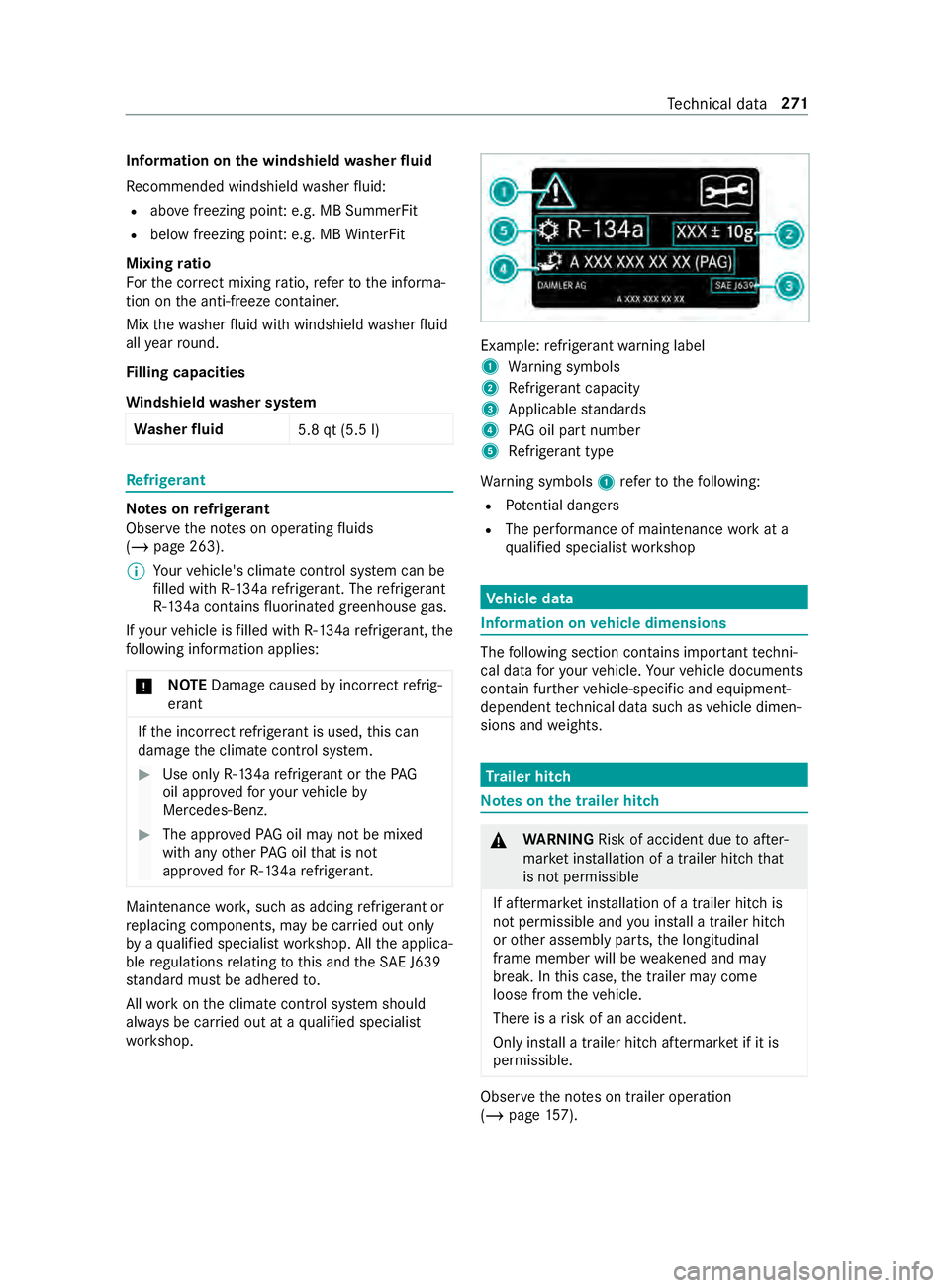
Information on
the windshield washer fluid
Re commended windshield washer fluid:
R abovefreezing point: e.g. MB SummerFit
R below freezing point: e.g. MB WinterFit
Mixing ratio
Fo rth e cor rect mixing ratio, referto the informa‐
tion on the anti-freeze container.
Mix thewa sher fluid with windshield washer fluid
all year round.
Fi lling capacities
Wi ndshield washer sy stem
Wa sher fluid
5.8 qt (5.5 l)Re
frigerant Note
s onrefrigerant
Obser vethe no tes on operating fluids
(/ page 263).
% Yo
ur vehicle's climate contro l system can be
fi lled with R‑134a refrigerant. The refrigerant
R‑134a contains fluorinated greenhouse gas.
If yo ur vehicle is filled with R‑134a refrigerant, the
fo llowing information applies:
* NO
TEDama gecaused byincor rect refrig‐
erant If
th e incor rect refrigerant is used, this can
damage the climate cont rol sy stem. #
Use only R‑134a refrigerant or thePAG
oil appr ovedfo ryo ur vehicle by
Mercedes-Benz. #
The appr ovedPA G oil may not be mixed
with any other PAG oil that is not
appr ovedfo r R‑134a refrigerant. Maintenance
work, such as adding refrigerant or
re placing components, may be car ried out only
by aqu alified specialist workshop. All the applica‐
ble regulations relating tothis and theSA E J639
st andard must be adhered to.
All workon the climate cont rol sy stem should
alw ays be car ried out at a qualified specialist
wo rkshop. Example:
refrigerant warning label
1 Warning symbols
2 Refrigerant capacity
3 Applicable standards
4 PAG oil part number
5 Refrigerant type
Wa rning symbols 1referto thefo llowing:
R Potential dangers
R The per form ance of main tenance workat a
qu alified specialist workshop Ve
hicle data Information on
vehicle dimensions The
following section con tains impor tant tech ni‐
cal da taforyo ur vehicle. Your vehicle documents
contain fur ther vehicle-specific and equipment-
dependent tech nical da tasuch as vehicle dimen‐
sions and weights. Tr
ailer hitch Note
s onthe trailer hit ch &
WARNING Risk of accident due toafte r‐
mar ket ins tallation of a trailer hitch that
is not permissible
If af term arke t ins tallation of a trailer hitch is
not permissible and you ins tall a trailer hitch
or other assembly parts, the longitudinal
frame member will be weakened and may
break. In this case, the trailer may come
loose from theve hicle.
There is a risk of an accident.
Only ins tall a trailer hitch af term arke t if it is
pe rm issible. Obser
vethe no tes on trailer operation
(/ page 157). Te
ch nical da ta271
Page 296 of 354
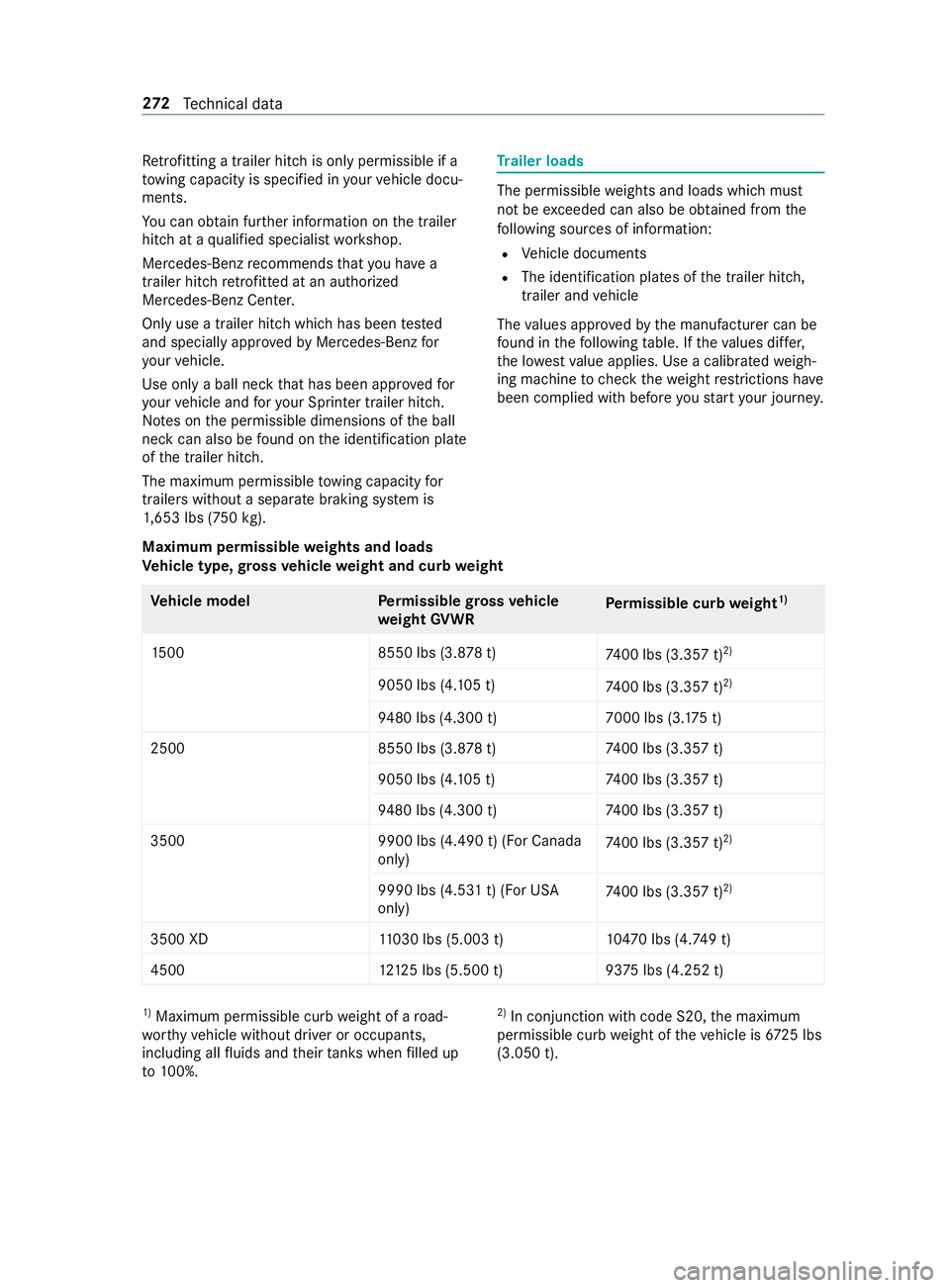
Re
trofitting a trailer hitch is only pe rmissible if a
to wing capacity is specified in your vehicle docu‐
ments.
Yo u can obtain fur ther information on the trailer
hitch at a qualified specialist workshop.
Mercedes-Benz recommends that you ha ve a
trailer hitch retrofitted at an au thorized
Mercedes-Benz Center.
Only use a trailer hitch which has been tested
and specially appr oved byMercedes-Benz for
yo ur vehicle.
Use only a ball neck that has been appr ovedfor
yo ur vehicle and foryo ur Sprinter trailer hit ch.
No tes on the permissible dimensions of the ball
neck can also be found on the identification plate
of the trailer hitch.
The maximum permissible towing capacity for
traile rswithout a separate braking sy stem is
1, 653 lbs (750 kg). Tr
ailer loads The permissible
weights and loads which must
not be exceeded can also be obtained from the
fo llowing sources of information:
R Vehicle documents
R The identification plates of the trailer hitch,
trailer and vehicle
The values appr ovedby the manufacturer can be
fo und in thefo llowing table. If theva lues dif fer,
th e lo west value applies. Use a calibrated weigh‐
ing machine tocheck thewe ight restrictions ha ve
been complied with before youstart your journe y.
Maximum permissible weights and loads
Ve hicle type, gross vehicle weight and curb weight Ve
hicle model Perm issible gross vehicle
we ight GVWR Pe
rm issible curb weight 1)
15 00 8550 lbs (3.878t)
7400 lbs (3.357 t) 2)
9050 lbs (4. 105 t)
7400 lbs (3.357 t) 2)
94 80 lbs (4.300 t) 7000 lbs (3.175 t)
2500 8550 lbs (3.878t) 7400 lbs (3.357 t)
9050 lbs (4. 105 t) 7400 lbs (3.357 t)
94 80 lbs (4.300 t) 7400 lbs (3.357 t)
3500 9900 lbs (4.490 t) (For Canada
only) 74
00 lbs (3.357 t) 2)
9990 lbs (4.531 t) (For USA
only) 74
00 lbs (3.357 t) 2)
3500 XD 11030 lbs (5.003 t) 10470 lbs (4.749 t)
4500 12125 lbs (5.500 t) 9375 lbs (4.252 t) 1)
Maximum permissible curb weight of a road‐
wo rthy vehicle without driver or occupants,
including all fluids and their tanks when filled up
to 100%. 2)
In conjunction with code S20, the maximum
permissible curb weight of theve hicle is 6725 lbs
(3.050 t). 272
Tech nical da ta
Page 297 of 354

Fr
ont axle load, rear axle load, gross weight of vehicle combination (se ries, optional)
Ve hicle types 1500 and 2500 with a max. permissible gross weight of 8550 lbs (3.8 78t) and
9050 lbs (4 .105 t) Pe
rm issible front axle load GAWR (FA) Perm issible rear axle load GAWR (RA)
41 00 lbs (1.860 t) 4)
5360 lbs (2.431 t)
44 10 lbs (2.000 t) 5360 lbs (2.431 t)Ve
hicle types 1500 and 2500 with a max. permissible gross weight of 9480 lbs (4.300 t) Pe
rm issible front axle load GAWR (FA) Perm issible rear axle load GAWR (RA)
44 10 lbs (2.000 t) 5360 lbs (2.431 t)Ve
hicle type 3500 with a max. permissible gross weight of 9900 lbs (4.490 t) (For Canada only)
and 9990 lbs (4.531 t) (For USA only) Pe
rm issible front axle load GAWR (FA) Perm issible rear axle load GAWR (RA)
4080 lbs (1.851 t) 4)
7060 lbs (3.202 t)
44 10 lbs (2.000 t) 7060 lbs (3.202 t)Ve
hicle type 3500 XD with a max. permissible gross weight of 11,030 lbs (5.003 t) Pe
rm issible front axle load GAWR (FA) Perm issible rear axle load GAWR (RA)
4080 lbs (1.851 t) 4)
7720 lbs (3.502 t)
44 10 lbs (2.000 t) 7720 lbs (3.502 t) Ve
hicle type 4500 with a max. permissible gross weight of 12,125 lbs (5.500 t) Pe
rm issible front axle load GAWR (FA) Perm issible rear axle load GAWR (RA)
4630 lbs (2. 100 t) 7935 lbs (3.599 t)3)
Maximum permissible gross weight of vehicle
and trailer combination.
4) Not in combination with all-wheel drive (4x4)
and not in combination with model series 90
7.74 5 (combination vehicles with a vehicle
length of 274.3 in (6967 mm))
Gross weight of vehicle combination, trailer load, tongue weight
Ve hicle types 1500 and 2500 with a max. permissible gross weight of 8550 lbs (3.8 78t) Pe
rm issible gross
we ight of vehicle/trailer
combination GCWR 3), 5)Pe
rm issible trailer load
GT W, braked 6) Pe
rm issible nose weight TWR
13 550 lbs (6. 146 t) 5000 lbs (2.270 t) 500 lbs (0.227 t) Te
ch nical da ta273
Page 298 of 354
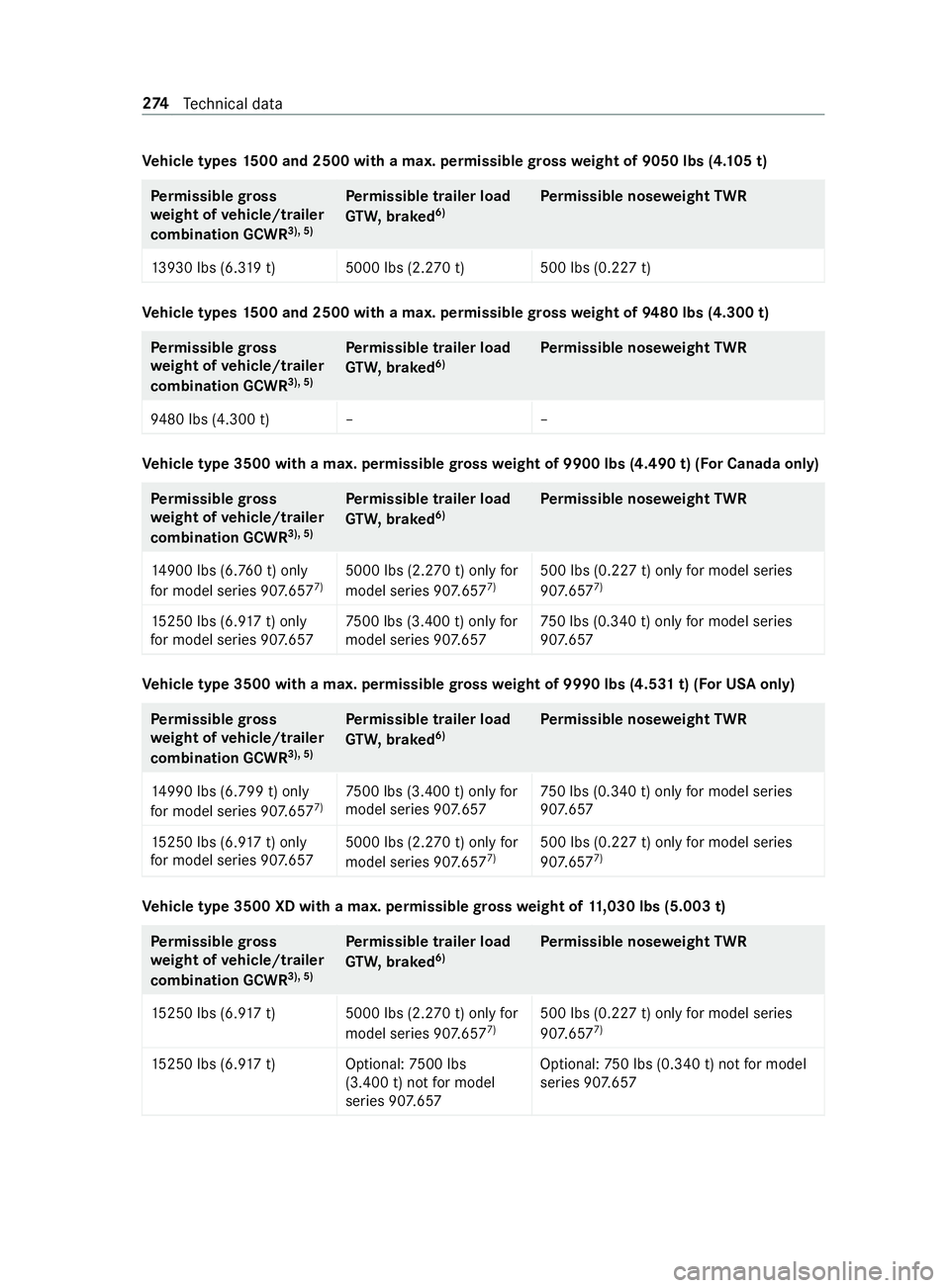
Ve
hicle types 1500 and 2500 with a max. permissible gross weight of 9050 lbs (4. 105 t) Pe
rm issible gross
we ight of vehicle/trailer
combination GCWR 3), 5)Pe
rm issible trailer load
GT W, braked 6) Pe
rm issible nose weight TWR
13 930 lbs (6.3 19t) 5000 lb s (2.270 t) 500 lbs (0.227 t) Ve
hicle types 1500 and 2500 with a max. permissible gross weight of 9480 lbs (4.300 t) Pe
rm issible gross
we ight of vehicle/trailer
combination GCWR 3), 5)Pe
rm issible trailer load
GT W, braked 6) Pe
rm issible nose weight TWR
94 80 lbs (4.300 t) ––Ve
hicle type 3500 with a max. permissible gross weight of 9900 lbs (4.490 t) (For Canada only) Pe
rm issible gross
we ight of vehicle/trailer
combination GCWR 3), 5)Pe
rm issible trailer load
GT W, braked 6) Pe
rm issible nose weight TWR
14 900 lbs (6.760 t) only
fo r model series 90 7.657 7) 5000 lbs (2.270 t) only
for
model series 90 7.657 7) 500 lbs (0.227 t) only
for model series
90 7.657 7)
15 250 lbs (6.9 17t) only
fo r model series 90 7.657 75
00 lbs (3.400 t) only for
model series 90 7.657 75
0 lbs (0.340 t) only for model series
90 7.657 Ve
hicle type 3500 with a max. permissible gross weight of 9990 lbs (4.531 t) (For USA only) Pe
rm issible gross
we ight of vehicle/trailer
combination GCWR 3), 5)Pe
rm issible trailer load
GT W, braked 6) Pe
rm issible nose weight TWR
14 990 lbs (6.799 t) only
fo r model series 90 7.657 7) 75
00 lbs (3.400 t) only for
model series 90 7.657 75
0 lbs (0.340 t) only for model series
90 7.657
15 250 lbs (6.9 17t) only
fo r model series 90 7.657 5000 lbs (2.270 t) only
for
model series 90 7.657 7) 500 lbs (0.227 t) only
for model series
90 7.657 7) Ve
hicle type 3500 XD with a max. permissible gross weight of 11,030 lbs (5.003 t) Pe
rm issible gross
we ight of vehicle/trailer
combination GCWR 3), 5)Pe
rm issible trailer load
GT W, braked 6) Pe
rm issible nose weight TWR
15 250 lbs (6.9 17t) 5000 lb s (2.270 t) only for
model series 90 7.657 7) 500 lbs (0.227 t) only
for model series
90 7.657 7)
15 250 lbs (6.9 17t) Optional: 7500 lbs
(3.400 t) not for model
series 90 7.657 Optional:
750 lbs (0.340 t) not for model
series 90 7.657 274
Tech nical da ta
Page 299 of 354
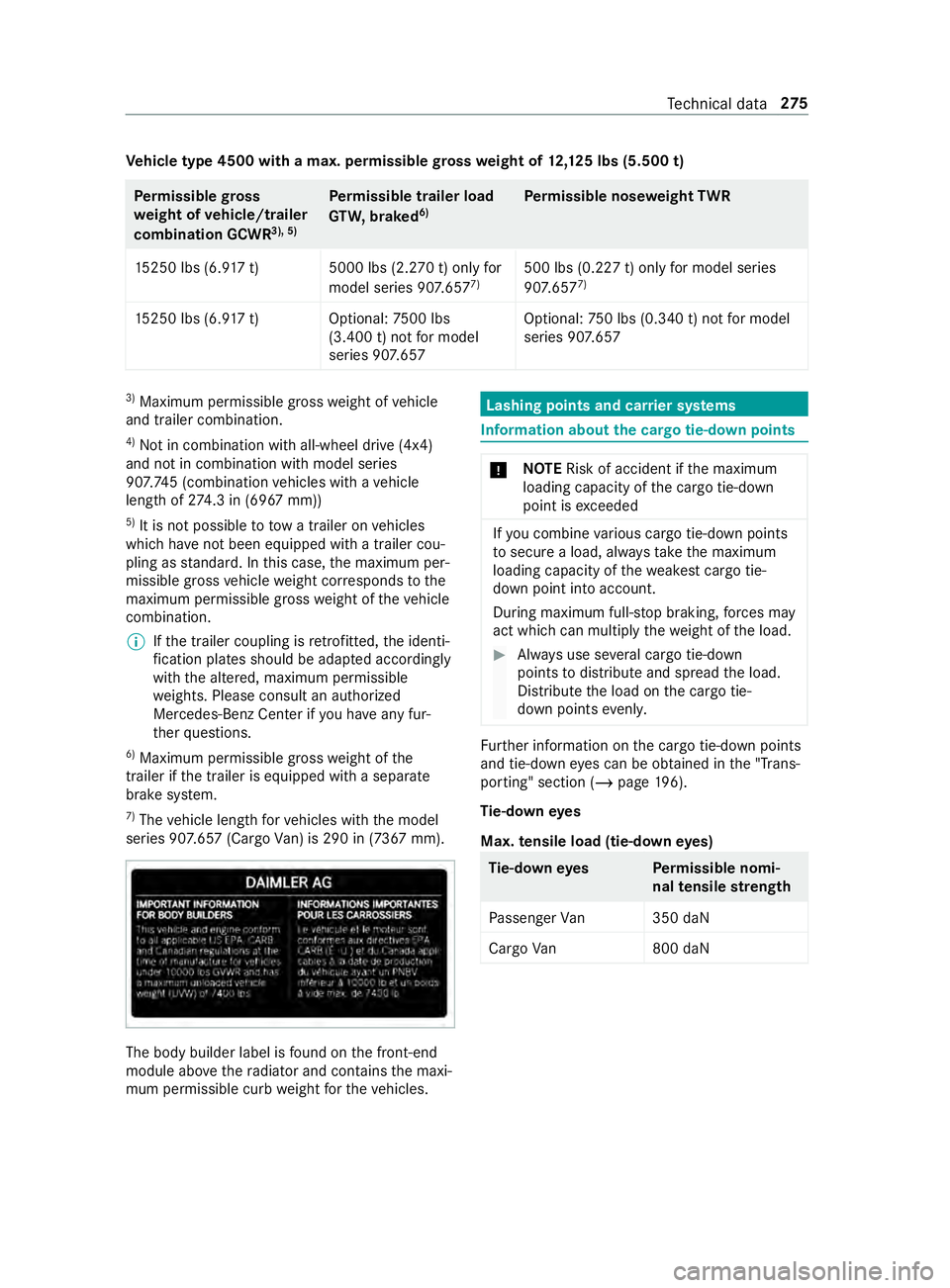
Ve
hicle type 4500 with a max. permissible gross weight of 12,125 lbs (5.500 t) Pe
rm issible gross
we ight of vehicle/trailer
combination GCWR 3), 5)Pe
rm issible trailer load
GT W, braked 6) Pe
rm issible nose weight TWR
15 250 lbs (6.9 17t) 5000 lb s (2.270 t) only for
model series 90 7.657 7) 500 lbs (0.227 t) only
for model series
90 7.657 7)
15 250 lbs (6.9 17t) Optional: 7500 lbs
(3.400 t) not for model
series 90 7.657 Optional:
750 lbs (0.340 t) not for model
series 90 7.657 3)
Maximum permissible gross weight of vehicle
and trailer combination.
4) Not in combination with all-wheel drive (4x4)
and not in combination with model series
90 7.74 5 (combination vehicles with a vehicle
length of 274.3 in (6967 mm))
5) It is not possible to tow a trailer on vehicles
which ha venot been equipped wi tha trailer cou‐
pling as standard. In this case, the maximum per‐
missible gross vehicle weight cor responds tothe
maximum permissible gross weight of theve hicle
combination.
% If
th e trailer coupling is retrofitted, the identi‐
fi cation pla tes should be adap ted according ly
with the altered, maximum permissible
we ights. Please consult an authorized
Mercedes-Benz Center if you ha veany fur‐
th er questions.
6) Maximum permissible gross weight of the
trailer if the trailer is equipped with a separate
brake sy stem.
7) The vehicle length forve hicles with the model
series 90 7.657 (Cargo Van) is 290 in (7367 mm). The body builder label is
found on the front-end
module abo vethera diator and con tains the maxi‐
mum permissible curb weight forth eve hicles. Lashing points and car
rier sy stems Information about
the cargo tie-down points *
NO
TERisk of accident if the maximum
loading capacity of the cargo tie-down
point is exceeded If
yo u combine various cargo tie-down points
to secure a load, alw aysta ke the maximum
loading capacity of thewe akest cargo tie-
down point into account.
During maximum full- stop braking, forc es may
act which can multiply thewe ight of the load. #
Always use se veral cargo tie-down
points todistribute and spread the load.
Distribute the load on the cargo tie-
down points evenly. Fu
rther information on the cargo tie-down points
and tie-down eyes can be obtained in the "T rans‐
porting" section (/ page 196).
Ti e-d owney es
Max. tensile load (tie-down eyes) Ti
e-d owney es Perm issible nomi‐
nal tensile stre ngth
Pa ssenger Van3 50 daN
Cargo Van8 00 daN Te
ch nical da ta275
Page 300 of 354

Loading
rails
Max. tensile load of cargo tie-down points in
cargo compartment Cargo tie-down
point
Pe
rm issible nomi‐
nal tensile stre ngth
Loading rails on cargo
compartment floor 500 daN
Lo we r loading rail on
side wall 200 daN
Up per loading rail on
side wall 12
5 daN The
values specified apply only toloads resting
on the cargo compartment floor if you obse rve
th efo llowing:
R the load is secured totwo cargo tie-down
points on thera il
R the dis tance tothe nearest load-securing
point on the same rail is appr oximately 1 m Information about
roof racks &
WARNING Risk of inju rydue tothe maxi‐
mum roof load being exceeded
When you place a load on thero of as well as
all outer and inner attachments, theve hicle's
center of gr avity will rise and thefa miliar driv‐
ing characteristics as well as thesteering and
braking characteristics will change. When
driving around bends, theve hicle will tilt
more heavily and may react more sluggishly
to steering mo vements.
If yo uexc eed the maximum roof load, the
driving characteristics, as well as thesteering
and braking, will be greatly impaired. #
Neverexc eed the maximum roof load
and adjust your driving style. &
WARNING Danger of accident due to
une ven loading
If yo u load theve hicle une venly, the handling
ch aracteristics as well as thesteering‑ and
braking characteristics can be heavily
impaired. #
Load theve hicle evenly. #
Secu rethe load against sliding. The driving, braking and
steering characteristics
of theve hicle change with the type of load, the
we ight and the center of gr avity of the load.
* NO
TERisk of accident if the maximum
permitted roof load is exceeded. If
th ewe ight of thero of luggage, including the
ro of rack ,exc eeds the maximum permitted
ro of load, there is a risk of an accident. #
Ensure that thewe ight of thero of lug‐
ga ge and roof rack toget her does not
exc eed the maximum permitted roof
load. #
The roof rack 's supporting feet must be
ar ranged at a uni form distan ce from
ea ch other. #
Mercedes-Benz recommends you ins tall
a st abilizer bar on theve hicle's front
axle. Fu
rther information about saf ety measures can
be found in the "T ranspo rt" section
(/ page 196).
Max. roof load / pairs of supporting roof rack
fe et Ve
hicles
with Maximum
ro
of load Minimum
number of
pairs of sup‐
porting
feet
Normal roof 661 lbs
(300kg) 6
High roof 331 lbs
(150kg) 3 This information applies if
the load is distributed
eve nly across the entire roof sur face.
If th ero of rack is shor ter,re duce the load propor‐
tionatel y.The maximum load per pair of support‐
ing roof rack feet is110 lbs (50 kg).
The loading guidelines and other information
about load distribution and load securing can be
fo und in the "T ranspo rt" section (/ page196). 276
Tech nical da ta